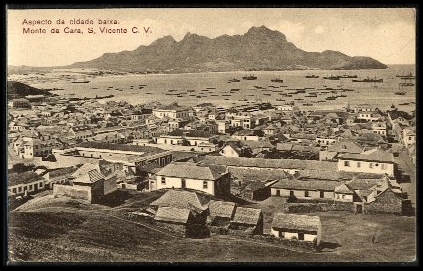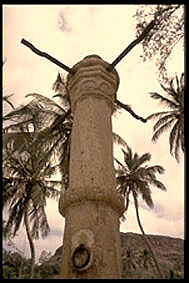|
Tornabenea Bischoffii
''Daucus insularis'' is a species of flowering plants of the family Apiaceae. The species is endemic to Cape Verde.Oromí, Martín, Zurita & Cabrera, 2005 : Lista preliminar de especies silvestres de Cabo Verde: Hongos, Plantas y Animales Terrestres.' Gobierno de Canarias, Consejería de Medio Ambiente y Ordenación Territorial, p. 41 The species was first described by Filippo Parlatore in 1849 as ''Tetrapleura insularis''. Distribution and ecology ''Daucus insularis'' occurs on the islands of Santo Antão, São Vicente, São Nicolau, Santiago Santiago (, ; ), also known as Santiago de Chile (), is the capital and largest city of Chile and one of the largest cities in the Americas. It is located in the country's central valley and is the center of the Santiago Metropolitan Regi ... and Brava. References {{Taxonbar, from=Q3532315 insularis Endemic flora of Cape Verde Plants described in 1850 ... [...More Info...] [...Related Items...] OR: [Wikipedia] [Google] [Baidu] |
Filippo Parlatore
Filippo Parlatore (Palermo, 8 August 1816 – Florence, 9 September 1877) was an Italian botanist. He studied medicine at Palermo, but practiced only for a short time, his chief activity being during the cholera epidemic of 1837. Although at that time he had been an assistant professor of anatomy, a subject on which he had already written (Treatise on the human retina), he soon gave up all other interests to devote his entire attention to botany. He first made a study of the flora of Sicily, publishing in 1838 ''Flora panormitana'' (Palermo); he also dealt with the Sicilian flora in later works. In 1840 he left home to begin his extended botanical expeditions. He travelled all through Italy, then into Switzerland (where he remained for a time at Geneva with De Candolle), to France (where he was at Paris with Webb, the Englishman) and to England, his longest stay being at Kew. His part in the Third Congress of Italian naturalists held at Florence in 1841 was of significance for hi ... [...More Info...] [...Related Items...] OR: [Wikipedia] [Google] [Baidu] |
Apiaceae
Apiaceae () or Umbelliferae is a family of mostly aromatic flowering plants named after the type genus ''Apium,'' and commonly known as the celery, carrot, or parsley family, or simply as umbellifers. It is the 16th-largest family of flowering plants, with more than 3,800 species in about 446 genus, genera,Stevens, P.F. (2001 onwards).APIACEAE Lindley, nom. cons. ''Angiosperm Phylogeny Website''. Retrieved 16 December 2022. including such well-known, and economically important plants as ajwain, angelica, anise, Ferula assa-foetida, asafoetida, caraway, carrot, celery, chervil, coriander, cumin, dill, fennel, lovage, cow parsley, parsley, parsnip and Eryngium maritimum, sea holly, as well as Silphium (antiquity), silphium, a plant whose exact identity is unclear and which may be extinct. The family Apiaceae includes a significant number of phototoxic species, such as giant hogweed, and a smaller number of highly poisonous species, such as Conium maculatum, poison hemlock, Cicuta, ... [...More Info...] [...Related Items...] OR: [Wikipedia] [Google] [Baidu] |
Cape Verde
Cape Verde or Cabo Verde, officially the Republic of Cabo Verde, is an island country and archipelagic state of West Africa in the central Atlantic Ocean, consisting of ten volcanic islands with a combined land area of about . These islands lie between west of Cap-Vert, the westernmost point of continental Africa. The List of islands of Cape Verde, Cape Verde islands form part of the Macaronesia ecoregion, along with the Azores, the Canary Islands, Madeira and the Savage Isles. The Cape Verde archipelago was uninhabited until the 15th century, when Portuguese Empire, Portuguese explorers colonized the islands, establishing one of the first Age of Discovery, European settlements in the tropics. Due to its strategic position, Cape Verde became a significant location in the Atlantic slave trade, transatlantic slave trade during the 16th and 17th centuries. The islands experienced economic growth during this period, driven by their role by the rapid emergence of merchants, priva ... [...More Info...] [...Related Items...] OR: [Wikipedia] [Google] [Baidu] |
Santo Antão, Cape Verde
Santo Antão (Portuguese language, Portuguese for "Anthony the Great, Saint Anthony") is the northwesternmost island of Cape Verde. At , it is the largest of the Barlavento Islands group, and the second largest island of Cape Verde.Cabo Verde, Statistical Yearbook 2015 Instituto Nacional de Estatística (Cape Verde), Instituto Nacional de Estatística The nearest island is São Vicente, Cape Verde, São Vicente to the southeast, separated by the sea channel Canal de São Vicente. Its population was 38,200 in mid 2019,Instituto Nacional de Estatística, Cabo Verde (web). making it the fourth most populous island of Cape Verde after Santiago, Cape Verde, Santiago, São Vicente and Sal. Its largest city is Porto Novo, Cape Verde, Porto Novo located on the ... [...More Info...] [...Related Items...] OR: [Wikipedia] [Google] [Baidu] |
São Vicente, Cape Verde
São Vicente (Portuguese language, Portuguese for "Vincent of Saragossa, Saint Vincent") is one of the Barlavento Islands, the northern group within the Cape Verde archipelago in the Atlantic Ocean, off the West Africa, West African coast. It is located between the islands of Santo Antão, Cape Verde, Santo Antão and Santa Luzia, Cape Verde, Santa Luzia, with the Canal de São Vicente separating it from Santo Antão. Geography The island is roughly rectangle, rectangular in shape with an area of . From east to west it measures and from north to south .Cabo Verde, Statistical Yearbook 2015 Instituto Nacional de Estatística (Cape Verde), Instituto Nacional de Estatística The island, of volcano, volcanic origin, is fairly flat. The last volcanic activity is considered to have t ... [...More Info...] [...Related Items...] OR: [Wikipedia] [Google] [Baidu] |
São Nicolau, Cape Verde
São Nicolau (Portuguese language, Portuguese for ''Saint Nicholas'') is one of the Barlavento Islands, Barlavento (Windward) islands of Cape Verde. It is located between the islands of Santa Luzia, Cape Verde, Santa Luzia and Sal, Cape Verde, Sal. Its population is 12,424 (2015),Cabo Verde, Statistical Yearbook 2015 Instituto Nacional de Estatística (Cape Verde), Instituto Nacional de Estatística with an area of . The main towns are Ribeira Brava, Cape Verde, Ribeira Brava and Tarrafal de São Nicolau. History The island was discovered in 1461 or 1462 by Diogo Afonso, together with the islands of São Vicente, Cape Verde, São Vicente and Santo Antão, Cape Verde, Santo Antão.[...More Info...] [...Related Items...] OR: [Wikipedia] [Google] [Baidu] |
Santiago, Cape Verde
Santiago (Portuguese language, Portuguese for “James, son of Zebedee, Saint James”) is the largest island of Cape Verde, its most important agricultural centre and home to half the nation's population. Part of the Sotavento Islands, it lies between the islands of Maio, Cape Verde, Maio ( to the east) and Fogo, Cape Verde, Fogo ( to the west). It was the first of the islands to be settled: the town of Ribeira Grande (now Cidade Velha and a UNESCO World Heritage Site) was founded in 1462. Santiago is home to the nation's capital city of Praia. History The eastern side of the nearby island of Fogo, Cape Verde, Fogo collapsed into the ocean 73,000 years ago, creating a tsunami high which struck Santiago. In 1460, António de Noli became the first to visit the island. Da Noli settled at ''Ribeira Grande'' (now Cidade Velha) with his family members and Portuguese from Algarve and Alentejo in 1462. [...More Info...] [...Related Items...] OR: [Wikipedia] [Google] [Baidu] |
Brava, Cape Verde
Brava (Portuguese Language, Portuguese for "wild" or "brave") is an island in Cape Verde, and is part of the Sotavento Islands, Sotavento group, in the central Atlantic Ocean. At , it is the smallest inhabited island of the Cape Verde archipelago, but at the same time the greenest. First settled in the early 16th century, its population grew after Mount Fogo on neighbouring Fogo, Cape Verde, Fogo erupted in 1680. For more than a century, its main industry was whaling, but the island economy is now primarily agricultural. History Brava was discovered in 1462 by the Portuguese people, Portuguese explorer Diogo Afonso.Valor simbólico do centro histórico da Praia Lourenço Conceição Gomes, Universidade Portucalense, 2008, p. 97 There is no evidence of human presence on the Cape Verde islands before the arrival of the ... [...More Info...] [...Related Items...] OR: [Wikipedia] [Google] [Baidu] |
Daucus
''Daucus'' is a worldwide genus of herbaceous plants of the celery family Apiaceae of which the best-known species is the cultivated carrot. ''Daucus'' has about 45 species. The oldest carrot fossil is 1.3 Ma, and was found on the island of Madeira in the Atlantic Ocean. Description Members of ''Daucus'' are distinguished within the family ''Apiaceae'' by their leaves which are 2–3 pinnatisect with narrow end sections. The genus primarily consists of biennial plants but also includes some annual plants and some perennial herbs. All ''Daucus'' have bristly stems. The inflorescences are umbels. The flowers are mostly white, with bracts and bracteoles. The petals may be pure white, reddish, pinkish or yellowish. They are emarginate above and have pointed, wrapped lobules. The petals are often unequal in size, with petals at the outermost edge of the inflorescence often being larger. The fruit is an ovoid to ellipsoidal schizocarp, cylindrical or compressed, with ciliate pr ... [...More Info...] [...Related Items...] OR: [Wikipedia] [Google] [Baidu] |
Endemic Flora Of Cape Verde
Endemism is the state of a species being found only in a single defined geographic location, such as an island, state, nation, country or other defined zone; organisms that are indigenous to a place are not endemic to it if they are also found elsewhere. For example, the Cape sugarbird is found exclusively in southwestern South Africa and is therefore said to be ''endemic'' to that particular part of the world. An endemic species can also be referred to as an ''endemism'' or, in scientific literature, as an ''endemite''. Similarly, many species found in the Western ghats of India are examples of endemism. Endemism is an important concept in conservation biology for measuring biodiversity in a particular place and evaluating the risk of extinction for species. Endemism is also of interest in evolutionary biology, because it provides clues about how changes in the environment cause species to undergo range shifts (potentially expanding their range into a larger area or becoming ... [...More Info...] [...Related Items...] OR: [Wikipedia] [Google] [Baidu] |




